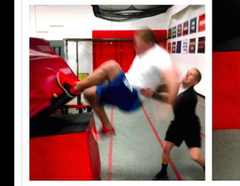Why did I decide to do it?
Because of the internet! This may be slightly tongue-in-cheek, but after a few sessions of working with box jumps most athletes would generate a curiosity of how high of a box could they jump up on. Or, better yet, they spent some time on YouTube and then generated an interest in jumping out of the shallow end of a swimming pool, or into a bed of a truck. Well, most people are smart enough not to attempt that, but for some reason they think it is safer to try on a box, or better yet boxes that are stacked on top of each other, or a stack of bumper plates.
Even without doing box jumps I still get the question; Can the plyo boxes be stacked to see how high I can jump? The answer is always... it depends on the IQ of the person stacking them.
This inevitably brings about the puppy dog look...
But lets change gears, is the box jump a good way to measure this type of power? In the video JJ Watt jumped up onto a 61" box. Athletes that are successful at jumping onto high boxes typically have two main qualities; they can generate a ton of force into the ground to propel them vertically, and they have enough hip mobility to pull their legs up almost even with their butt to land on the box. Watt clearly has both. Lets look at a snap shot from the video as he lands the jump.
Wrong!
JJ's hips were 4" above the box (roughly) when he landed. That puts his hips at 65" (5'5"). I've seen some numbers for average percentage measuring waist height to true height being at 48%. That would be 37" (3'1") to JJ's overall height 77" (6'5") when standing. So taking all of those numbers into account JJ displaced his hip 28". I'm not trying to take away anything from what he did, but at this years NFL Combine not one DE (the position Watt plays) jumped under 29", and going back to his NFL Combine, Watt jumped 37". Vertical Jump is a much more accurate and safer way to express this type of power output. It just is not as impressive on video.
So to me this is a very risky method to displace your hips 28". The boxes that JJ jumped on are very forgiving on the shins (typically the area that hits the box when a jump is missed) but there is still a lot of risk that I would not have any athlete attempt. Nore would I try and spot him, or anyone else for that matter.
So is there a way to test athletes jumping ability that is safer?
Yes, vertical jump.
Is there a way to test them that looks cooler on the internet?
Yes, but does that matter?
To me no, but athletes love to compete and set challenges for themselves and I can respect that. We have allowed some athletes to challenge themselves with a hurdle jump. It is not included in our programming, but it is a fun little challenge that does not impose as many safety concerns as a box jump, as a missed attempt just knocks the hurdle over. Here is what it looks like.
So I believe this is a much safer method to use, although still not necessary. And it can be used to compare athletes and let them create some competition against one another.
So who won between JJ and Alex..... Scroll up and read the title of the blog.







 RSS Feed
RSS Feed